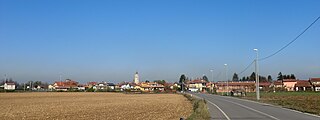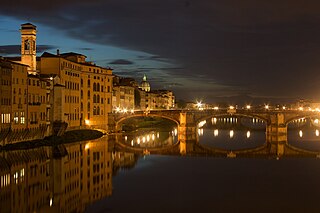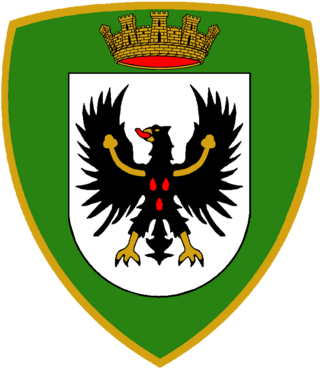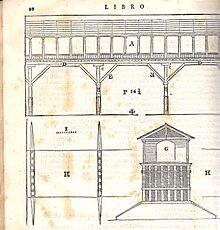
The Ponte Vecchio is a medieval stone closed-spandrel segmental arch bridge over the Arno, in Florence, Italy. The only bridge in Florence spared from destruction during World War II, it is noted for the shops built along it; building shops on such bridges was once a common practice. Butchers, tanners, and farmers initially occupied the shops; the present tenants are jewellers, art dealers, and souvenir sellers. The Ponte Vecchio's two neighbouring bridges are the Ponte Santa Trinita and the Ponte alle Grazie.

Vicenza ; Venetian: Vicensa[viˈtʃeŋ(t)sa]) is a city in northeastern Italy. It is in the Veneto region, at the northern base of the Monte Berico, where it straddles the Bacchiglione River. Vicenza is approximately 60 kilometres (37 mi) west of Venice and 200 kilometres (120 mi) east of Milan.

Vincenzo Scamozzi was an Italian architect and a writer on architecture, active mainly in Vicenza and Republic of Venice area in the second half of the 16th century. He was perhaps the most important figure there between Andrea Palladio, whose unfinished projects he inherited at Palladio's death in 1580, and Baldassarre Longhena, Scamozzi's only pupil.

Andrea Palladio was an Italian Renaissance architect active in the Venetian Republic. Palladio, influenced by Roman and Greek architecture, primarily Vitruvius, is widely considered to be one of the most influential individuals in the history of architecture. While he designed churches and palaces, he was best known for country houses and villas. His teachings, summarized in the architectural treatise, The Four Books of Architecture, gained him wide recognition.

Pulteney Bridge is a bridge over the River Avon in Bath, England. It was completed by 1774, and connected the city with the land of the Pulteney family which it wished to develop. Designed by Robert Adam in a Palladian style, it is highly unusual in that it has shops built across its full span on both sides. It has been designated as a Grade I listed building.

The Brenta is an Italian river that runs from Trentino to the Adriatic Sea just south of the Venetian lagoon in the Veneto region, in the north-east of Italy.

Bassano del Grappa is a city and comune, in the Vicenza province, in the region of Veneto, in northern Italy. It bounds the communes of Cassola, Marostica, Solagna, Pove del Grappa, Romano d'Ezzelino, Campolongo sul Brenta, Conco, Rosà, Cartigliano and Nove. Some neighbourhoods of these communes have become in practice a part of the urban area of Bassano, so that the population of the whole conurbation totals around 70,000 people.

The Rialto Bridge is the oldest of the four bridges spanning the Grand Canal in Venice, Italy. Connecting the sestieri (districts) of San Marco and San Polo, it has been rebuilt several times since its first construction as a pontoon bridge in 1173, and is now a significant tourist attraction in the city.

Valstagna is a town and comune in the province of Vicenza, Veneto, northern Italy, It is connected to the frazione Carpanè of San Nazario by a bridge and it is accessible by SS47 Provincial Road.The biggest towns nearby Valstagna are Bassano del Grappa, Marostica, Asiago, Trento and Venice.

Montanera is a comune (municipality) in the Province of Cuneo in the Italian region Piedmont, located about 70 kilometres (43 mi) south of Turin and about 13 kilometres (8 mi) northeast of Cuneo.

The Ponte Santa Trìnita is a Renaissance bridge in Florence, Italy, spanning the Arno. The Ponte Santa Trìnita is the oldest elliptic arch bridge in the world, characterised by three flattened ellipses. The outside spans each measure 29 m (95 ft) with the centre span being 32 m (105 ft) in length. The two neighbouring bridges are the Ponte Vecchio, to the east, and the Ponte alla Carraia to the west.
Poli Distillerie is an artisan Grappa distillery solely owned by the Poli family, founded in 1898 in Schiavon, near Bassano del Grappa, in the heart of Veneto, Italy. The distillery is currently run by Jacopo Poli together with his siblings Giampaolo, Barbara and Andrea.

The Alpine Brigade "Cadore" was a light Infantry brigade of the Italian Army, specializing in mountain warfare. Its core units were Alpini, the mountain infantry corps of the Italian Army, that distinguished itself in combat during World War I and World War II. The brigade was based in the Italian provinces of Belluno and Vicenza with its headquarters Belluno. The brigade was disbanded in 1997.

The Alpine Brigade "Tridentina" was a light Infantry brigade of the Italian Army, specializing in mountain warfare. Its core units were Alpini, the mountain infantry corps of the Italian Army, that distinguished itself in combat during World War I and World War II. The Alpine Brigade "Tridentina" carried on the colours and traditions of the WWII 2nd Alpine Division "Tridentina".

The 6th Alpini Regiment is a training regiment of the Italian Army's mountain infantry speciality, the Alpini, which distinguished itself in combat during World War I and World War II. The regiment is based in Bruneck and assigned to the Alpine Training Center.

The Alpini are a mountain infantry corps of the Italian Army, that distinguished itself in combat during World War I and World War II. They are also famous in Italy for their songs and choirs.
Ponte Vecchio may refer to:
The Alpini are elite soldiers of the Italian Army who specialize in mountain warfare.
AntonioGaidon (1738–1829), was an architect, urban planner and naturalist.

















